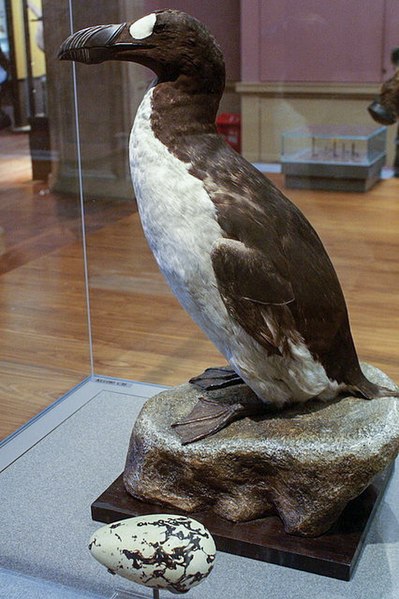Fișier:Great Auk (Pinguinis impennis) specimen, Kelvingrove, Glasgow - geograph.org.uk - 1108249.jpg

Mărimea acestei previzualizări: 399 × 599 pixeli. Alte rezoluții: 160 × 240 pixeli | 426 × 640 pixeli.
Mărește rezoluția imaginii (426 × 640 pixeli, mărime fișier: 271 KB, tip MIME: image/jpeg)
Istoricul fișierului
Apăsați pe Data și ora pentru a vedea versiunea trimisă atunci.
| Data și ora | Miniatură | Dimensiuni | Utilizator | Comentariu | |
|---|---|---|---|---|---|
| actuală | 11 august 2017 12:26 |  | 426x640 (271 KB) | Archaeodontosaurus | Corrections |
| 24 februarie 2011 20:46 |  | 426x640 (78 KB) | GeographBot | == {{int:filedesc}} == {{Information |description={{en|1=Great Auk (Pinguinis impennis) specimen, Kelvingrove, Glasgow A lost part of the biogeography of Britain, and the only flightless bird that has bred in Europe in historical times. The last Great Auk |
Utilizarea fișierului
Următoarele pagini conțin această imagine:
Utilizarea globală a fișierului
Următoarele alte proiecte wiki folosesc acest fișier:
- Utilizare la ar.wikipedia.org
- Utilizare la arz.wikipedia.org
- Utilizare la ast.wikipedia.org
- Utilizare la as.wikipedia.org
- Utilizare la az.wikipedia.org
- Utilizare la bg.wikipedia.org
- Utilizare la bn.wikibooks.org
- Utilizare la ca.wikipedia.org
- Utilizare la da.wikipedia.org
- Utilizare la de.wikipedia.org
- Utilizare la en.wikipedia.org
- Utilizare la en.wikibooks.org
- Utilizare la en.wiktionary.org
- Utilizare la es.wikipedia.org
- Utilizare la et.wikipedia.org
- Utilizare la eu.wikipedia.org
- Utilizare la fa.wikipedia.org
- Utilizare la fi.wiktionary.org
- Utilizare la fo.wikipedia.org
- Utilizare la fr.wikipedia.org
- Utilizare la fy.wikipedia.org
- Utilizare la ga.wikipedia.org
- Utilizare la gd.wikipedia.org
- Utilizare la gl.wikipedia.org
- Utilizare la he.wikipedia.org
- Utilizare la ia.wikipedia.org
- Utilizare la it.wikipedia.org
- Utilizare la ja.wiktionary.org
- Utilizare la jv.wikipedia.org
- Utilizare la la.wikipedia.org
- Utilizare la lv.wikipedia.org
- Utilizare la ml.wikipedia.org
- Utilizare la mrj.wikipedia.org
- Utilizare la no.wikipedia.org
Vizualizați utilizările globale ale acestui fișier.

